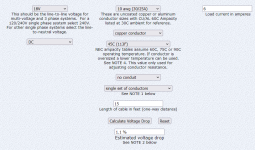I miss tailwheel Charlie, if I'm remembering correctly.
It doesn't have to be that complicated. The voltage drop will be the greatest at maximum amp flow during the hottest temperature the wire is before carrying current. Then it gets hotter.
It's difficult to measure voltage drop by measuring at the panel, and then scurrying to the charge controller with the meter. By then the sun, heat, and charging current the battery allows can change. It can be done with bright sun and a discharged battery accepting maximum amps for a while, especially with lithium.
MC4 connectors make it difficult to measure panel voltage. Anderson connectors make it easy.
It's also difficult to measure actual voltage drop across each wire from solar panel to charge controller because of distance and obstacles. Today's meters "borrow" negligible current while measuring voltage. Making long test leads from something like very small gauge telephone wire connected to one wire at the panel and the other at the controller allows that. Measure both positive and negative wire voltage drops and add them together. Multiply by amps to obtain lost watts. That loss will decrease as amps decrease as the battery charges.
Before installing, having the solar panel(s), wire, charge controller, and battery close together, allows measuring everything more easily, with the exception that wire inside something can get hotter than ambient. That may convince you to use a smaller, easier to work with wire size.
Amp readings seem to be the middle child in simple DC solar systems. Most of the other more advanced terms are derived from it. Except for the rapid pulsing of PWM charge controllers, which don't or very little when delivering maximum amps, it's a rehash of the very beginning of a DC fundamentals study. If you obtain a maximum current reading at initial installation, reduced amps are an early indication of mostly wiring connection issues later on. A clip on DC ammeter should be in every simple solar system's toolbox.
It's easy to get caught up in whatever Code Bible you follow. Much like religion, they often contradict each other. They do have reasons to exist.
It doesn't have to be that complicated. The voltage drop will be the greatest at maximum amp flow during the hottest temperature the wire is before carrying current. Then it gets hotter.
It's difficult to measure voltage drop by measuring at the panel, and then scurrying to the charge controller with the meter. By then the sun, heat, and charging current the battery allows can change. It can be done with bright sun and a discharged battery accepting maximum amps for a while, especially with lithium.
MC4 connectors make it difficult to measure panel voltage. Anderson connectors make it easy.
It's also difficult to measure actual voltage drop across each wire from solar panel to charge controller because of distance and obstacles. Today's meters "borrow" negligible current while measuring voltage. Making long test leads from something like very small gauge telephone wire connected to one wire at the panel and the other at the controller allows that. Measure both positive and negative wire voltage drops and add them together. Multiply by amps to obtain lost watts. That loss will decrease as amps decrease as the battery charges.
Before installing, having the solar panel(s), wire, charge controller, and battery close together, allows measuring everything more easily, with the exception that wire inside something can get hotter than ambient. That may convince you to use a smaller, easier to work with wire size.
Amp readings seem to be the middle child in simple DC solar systems. Most of the other more advanced terms are derived from it. Except for the rapid pulsing of PWM charge controllers, which don't or very little when delivering maximum amps, it's a rehash of the very beginning of a DC fundamentals study. If you obtain a maximum current reading at initial installation, reduced amps are an early indication of mostly wiring connection issues later on. A clip on DC ammeter should be in every simple solar system's toolbox.
It's easy to get caught up in whatever Code Bible you follow. Much like religion, they often contradict each other. They do have reasons to exist.

